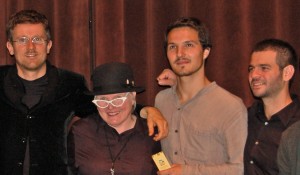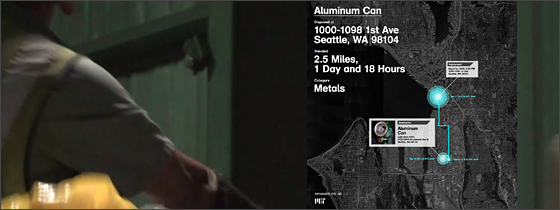
Amanda with Carlo Ratti, Kristian Kloecki and Assaf Biderman of the MIT Senseable City Lab
The goals of the project are to learn more about the “removal chain”, to promote new social behaviors relative to trash, and to ponder the feasibility of 100% trackability of material. Someday you may be able to push a small button on your old TV set, put it out at the curb, and it will call the manufacturer with a message that says, “I’m at such and such location. Come and get me.”
As Tim Croll of Seattle Public Utilities says, we are entering an era of “product stewardship” that no longer stops with the Supply Chain, but also includes the Removal Chain. Rita Smith, the education director for Waste Management, another sponsor of the project, says that her company and the citizens of Seattle are happy to be airing our dirty laundry as we move beyond the “out of sight out of mind” mentality and become more aware and informed about where trash is taking us and where we are putting it. The citizens of Seattle are dedicated recyclers. In fact 50% of our yearly throw aways (400,000 tons in 2008) gets turned back into useable stuff. But can we do more?
Have you ever asked yourself when throwing something away – “Where is away?” As we become more aware of our planet, and our responsibility to it and to each other, this question is becoming more and more important. In truth there is no “away” there is only someplace else or as we are discovering, some other “new life” for our trash.

electronic trash tag - it's a tiny cell phone!
Here’s a look at the tag this team has developed. It can literally “phone home” to tell data gatherers where it is. Each device has a motion sensor and it’s really a tiny cell phone that calls out when it is moving. This weensie device, about the size of a pack of gum, will work for up to two months. A new version in the works could be transmitting for as long as 6 months.
Marrying the data to Google Maps allows the team to display real-time images of the route our stuff takes from our trash can to its destination. Thus a tossed out pop can in Seattle can be seen arriving at a metals recycling center (Because it was disposed of properly in a recyling bin!) This, by the way, busts the urban myth that our stuff all gets dumped and not recycled!

A soda can travels on its way to be reclaimed
What would our world be like if each one of us took responsibility for our “stuff” from before we acquire it to after we no longer need it? Would we be more thoughtful about what we buy? Would we see the value of things even after we don’t want them? Would we do more to ensure that reusable materials re-enter the technosphere and that what goes back into the biosphere is not harmful to it?
The next Seattle deployment of tagged garbage will go out in a couple of weeks. You can vounteer to be a tagger by contacting senseable-volunteers@mit.edu. Trash is also being tagged in London and New York.
Read On!
Amanda Lorenzo
Leave a Reply